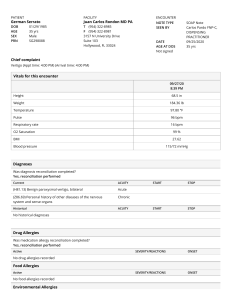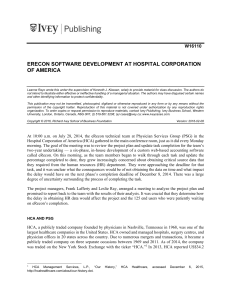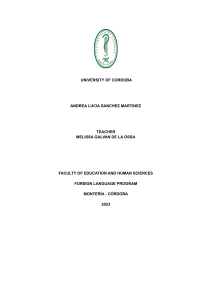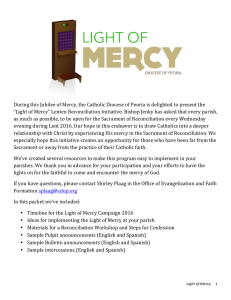Antecedents of the attitude towards inter-group
Anuncio
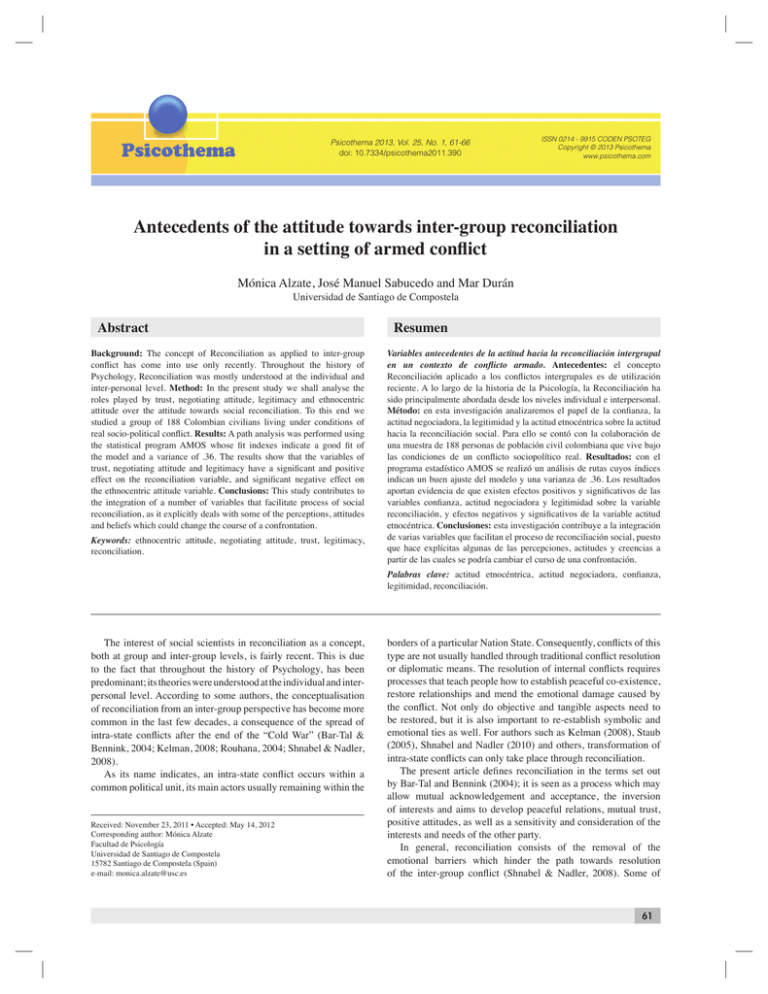
Psicothema 2013, Vol. 25, No. 1, 61-66 doi: 10.7334/psicothema2011.390 ISSN 0214 - 9915 CODEN PSOTEG Copyright © 2013 Psicothema www.psicothema.com Antecedents of the attitude towards inter-group reconciliation in a setting of armed conflict Mónica Alzate, José Manuel Sabucedo and Mar Durán Universidad de Santiago de Compostela Abstract Background: The concept of Reconciliation as applied to inter-group conflict has come into use only recently. Throughout the history of Psychology, Reconciliation was mostly understood at the individual and inter-personal level. Method: In the present study we shall analyse the roles played by trust, negotiating attitude, legitimacy and ethnocentric attitude over the attitude towards social reconciliation. To this end we studied a group of 188 Colombian civilians living under conditions of real socio-political conflict. Results: A path analysis was performed using the statistical program AMOS whose fit indexes indicate a good fit of the model and a variance of .36. The results show that the variables of trust, negotiating attitude and legitimacy have a significant and positive effect on the reconciliation variable, and significant negative effect on the ethnocentric attitude variable. Conclusions: This study contributes to the integration of a number of variables that facilitate process of social reconciliation, as it explicitly deals with some of the perceptions, attitudes and beliefs which could change the course of a confrontation. Keywords: ethnocentric attitude, negotiating attitude, trust, legitimacy, reconciliation. Resumen Variables antecedentes de la actitud hacia la reconciliación intergrupal en un contexto de conflicto armado. Antecedentes: el concepto Reconciliación aplicado a los conflictos intergrupales es de utilización reciente. A lo largo de la historia de la Psicología, la Reconciliación ha sido principalmente abordada desde los niveles individual e interpersonal. Método: en esta investigación analizaremos el papel de la confianza, la actitud negociadora, la legitimidad y la actitud etnocéntrica sobre la actitud hacia la reconciliación social. Para ello se contó con la colaboración de una muestra de 188 personas de población civil colombiana que vive bajo las condiciones de un conflicto sociopolítico real. Resultados: con el programa estadístico AMOS se realizó un análisis de rutas cuyos índices indican un buen ajuste del modelo y una varianza de .36. Los resultados aportan evidencia de que existen efectos positivos y significativos de las variables confianza, actitud negociadora y legitimidad sobre la variable reconciliación, y efectos negativos y significativos de la variable actitud etnocéntrica. Conclusiones: esta investigación contribuye a la integración de varias variables que facilitan el proceso de reconciliación social, puesto que hace explícitas algunas de las percepciones, actitudes y creencias a partir de las cuales se podría cambiar el curso de una confrontación. Palabras clave: actitud etnocéntrica, actitud negociadora, confianza, legitimidad, reconciliación. The interest of social scientists in reconciliation as a concept, both at group and inter-group levels, is fairly recent. This is due to the fact that throughout the history of Psychology, has been predominant; its theories were understood at the individual and interpersonal level. According to some authors, the conceptualisation of reconciliation from an inter-group perspective has become more common in the last few decades, a consequence of the spread of intra-state conflicts after the end of the “Cold War” (Bar-Tal & Bennink, 2004; Kelman, 2008; Rouhana, 2004; Shnabel & Nadler, 2008). As its name indicates, an intra-state conflict occurs within a common political unit, its main actors usually remaining within the Received: November 23, 2011 • Accepted: May 14, 2012 Corresponding author: Mónica Alzate Facultad de Psicología Universidad de Santiago de Compostela 15782 Santiago de Compostela (Spain) e-mail: [email protected] borders of a particular Nation State. Consequently, conflicts of this type are not usually handled through traditional conflict resolution or diplomatic means. The resolution of internal conflicts requires processes that teach people how to establish peaceful co-existence, restore relationships and mend the emotional damage caused by the conflict. Not only do objective and tangible aspects need to be restored, but it is also important to re-establish symbolic and emotional ties as well. For authors such as Kelman (2008), Staub (2005), Shnabel and Nadler (2010) and others, transformation of intra-state conflicts can only take place through reconciliation. The present article defines reconciliation in the terms set out by Bar-Tal and Bennink (2004); it is seen as a process which may allow mutual acknowledgement and acceptance, the inversion of interests and aims to develop peaceful relations, mutual trust, positive attitudes, as well as a sensitivity and consideration of the interests and needs of the other party. In general, reconciliation consists of the removal of the emotional barriers which hinder the path towards resolution of the inter-group conflict (Shnabel & Nadler, 2008). Some of 61 Mónica Alzate, José Manuel Sabucedo and Mar Durán the elements which constitute these barriers or that may boost reconciliation are depicted by Maoz (2004), broken down into two large categories: a) the perceptual biases that each party has developed about itself and its opponents; and b) the frames that promote reconciliation. Based on this classification, this article proposes a model that reintroduces four variables which could have a bearing on the process of reconciliation: ethnocentric attitude, negotiating attitude, the perceived legitimacy of the adversary and outgroup trust. The first of these variables corresponds to Maoz’s first category (2004), and the other three to the second. Each of these variables are detailed below. Ethnocentric attitude entails ingroup favourability bias. Classic studies in Social Psychology, such as those by LeVine and Campbell (1972) and Sherif, Harvey, White, Hood and Sherif (1961) show how interaction with a competitive and threatening outgroup is related to an increase in ethnocentrism. Likewise, recent research, such as that undertaken by Kinzel and Fisher (1993) has demonstrated that ethnocentrism lies at the core of the conflict escalation. Thus, where inter-group conflicts arise, each of the parties may tend to perceive itself in a favorable way, which leads to the praising of its own group and to the perception of being more virtuous than the adversary. Ethnocentric attitudes make it more difficult for the groups to acknowledge the negative consequences of their actions, their responsibilities during the conflict and the notion that the conflict has caused suffering to both parties. All this will make the process of reconciliation more difficult (Bar-Siman-Tov, 2004). Likewise, ethnocentrism incites a negative image of the other side that may favor hostility, hate and violence (Brewer, 2007). The second variable proposed by this study is negotiating attitude. This is a process in which the willingness to seek out and fulfill the common interests of all sides involved in the conflict is enhanced. Fisas (2004) highlights three aspects of the negotiating process: the conviction that any achievement is better than prolonging the existing situation, that results and satisfaction are sought by all parties, and that all parties are likely to make concessions. Negotiating is an important step towards the restoration of the social order and peace, but according to Long and Brecke (2003), it is not enough on its own. Other variables have to be considered as well. The third variable which is proposed in this model is that of trust, an element that enables the frames of polarization between the parts to be modified. This is a recurring variable in different studies on constructive conflict transformation. Redress of trust is a condition which increases the possibilities of reconciliation and the resolution of conflicts (Davidson, McElwee, & Hannan, 2004; Kelman, 2005; Lewicki & Wiethoff, 2000; Mukashema & Mullet, 2010). The fourth variable in the model is legitimacy, which is understood as the justification and acceptance of the adversary’s actions (Spears, 2008 p. 330). Through legitimacy, groups assess whether the aims and strategies used by the others are as commendable as their own. It also helps to create the perception that the arguments of the “other side” are as valid as one’s own, even if they are not shared. Not perceiving this legitimacy widens inter-group differentiation and increases competition between groups (Bar-Tal, 1990). In accordance with the abovementioned variables – ethnocentric attitude, negotiating attitude, trust and legitimacy – the main objective of this study is to create a model that will allow us to determine the role of these variables in the development of a 62 reconciliatory attitude amongst a group of civilians living in a conflict setting. Special emphasis will be placed on the segment of population that is not directly involved in the armed conflict, as this group is a fundamental part of the conflict transformation process owing to the direct influence it has on decisions made by conflicting sides (Sabucedo, Rodríguez, & López, 2000). We have also set out a model for a current conflict, as per Kelman’s thesis (2008). According to this author, reconciliation is a process that may begin even before any peace agreement is signed. Furthermore, reconciliation is not only a consequence of the successful resolution of a conflict; it is a process which constitutes the beginning of a peace process and which must be considered a comprehensive part of it. Some of the current models have addressed reconciliation during post-conflict stages, as in the case of Noor, Brown, González, Manzi and Lewis (2008) and Noor, Brown and Prentice (2008). In their studies, models are composed of variables based on previous forgiveness or which serve as a mediation to it and to inter-group reconciliation. These models were validated amongst university students in countries where two different communities were in conflict: Protestants and Catholics in Northern Ireland as well as left and right-wing in Chile. The conflicts studied by these authors divided their respective societies into clear factions; the model we propose in this study represents a new approach oriented to a population that is not actively participating in a current armed conflict. In order to validate the aim of our research, we have based our work on the real-life case of the Colombian socio-political conflict, with our focus being on the civilian population. While not direct participants, this segment of the population can still be considered part of this conflict, playing an important role in the process of reconciliation. According to Bar-Tal and Bennink (2004), in order to achieve a stable reconciliation, transformation has to go beyond the decisions made by political leaders and has to allow for changes in the motivations, objectives, beliefs, attitudes and emotions of the entire society. Due to the special characteristics of the context in which our research was conducted, some background information is provided below: Political conflict in Colombia This conflict has lasted for more than 50 years, and is based on the unequal distribution of the country’s resources (land, wealth, political power, etc.) and on the use of repressive strategies to counteract social problems. During the 1960s and 1970s, a number of guerrilla groups were organized (FARC - Revolutionary Armed Forces of Colombia; ELN - National Liberation Army; EPL Popular Liberation Army; M-19 –the 19th of April Movement; amongst others). They sought social change in order to promote a fair distribution of wealth and power. The 1980s and 1990s saw the rise of several paramilitary groups the aim of which being to counteract guerrilla warfare. The armed conflict is composed of three actors: guerrilla groups, government and paramilitary groups. Besides its economical and political consequences, this conflict has led to dramatic consequences for the civilian population. Some figures taken during the year under study illustrate this context: nearly two-thirds of the victims killed as a result of the conflict were civilians, and only one third of them were members of the illegal groups themselves (Salamanca, 2008); 3.7 million people (8.5% of the country’s population) have suffered internal Antecedents of the attitude towards inter-group reconciliation in a setting of armed conflict displacement (United Nations High Commissioner for Refugees – UNHCR, 2011); 3000 probable cases of “extrajudicial execution” were attributed to the Army between 2004 and 2008 and 51310 people have disappeared under forced circumstances (Office of the High Commissioner for Human Rights –OHCHR–, 2011). In addition, there are numerous structural causes which lie at the origin of the conflict. Although Colombia enjoys a high Human Development Index (HDI) with respect to other Latin American countries, its Extreme Poverty Index (16%) is amongst the highest in the region. Moreover, the Gini index for 2010 places the country amongst the seven most unequal countries of the planet (UNDP United Nations Development Programme, 2010). Method Participants The sample was composed of 188 Colombian civilians (57 men and 131 women; with an average age of 32.5 and a standard deviation of 10.97). Participants volunteered freely in interviews and were contacted through different social organizations, neighbourhood and students’ associations, NGOs and government Humanitarian Aid programmes. Procedure The variables were measured through the individual Psychosocial Disposition towards Conflict questionnaire (PDCQ), which was specifically developed for this study and whose psychometrically validated data was published by Alzate, Durán and Sabucedo, 2009. For the present paper, scales that measured trust, ethnocentric attitude, legitimacy, negotiating attitude and reconciliation were used. Instruments Apart from the socio-demographic information, all other items in the questionnaire featured rating scale questions that ranged from 1 (totally agree) to 5 (totally disagree). Ethnocentric attitude was rated according to Kinzel and Fisher (1993), using six questions covering: hate and threatening feelings; expression of disdain and antagonism towards the outgroup; attribution of negative features to the other; use of certain arguments which may be considered an attack on the other party; feelings of mistrust; and polarization of the population’s position towards the outgroup (α= .73). Negotiating attitude was measured through five items, following Fisas (2004): favorable attitude towards negotiation; positive consequences of negotiation; willingness to renounce; willingness to make concessions; and an attitude of preference towards a pacific coexistence instead of the honor of an armed victory (α= .69). Trust was evaluated through three items: the “good intentions” of the groups which took up arms; the coherence between their words and their actions; and the sincerity of the relations between those who took up arms and citizens (α= .66). Legitimacy was measured through two items, one which evaluates the aims and another which evaluates the strategies of those who took up arms (α= .62). The six items employed to evaluate the preference towards reconciliation are based on Bar-Tal and Bennink’s (2004) proposal and measures: the level of accordance with the egalitarian treatment of the groups which took up arms; the recognition of their civil rights; the recognition of their political rights; the possibility of sharing common spaces; establishing common aims; and disposition towards cooperative aims (α= .86). Data analysis To develop an integrated model that explains attitudes towards reconciliation, Pearson’s correlation was established between the variables. The mediator role as well as the model’s fit and its predicting capacity with regard to the reconciliation variable were analysed. The correlations were obtained through SPSS software. As far as mediation is concerned, both the magnitude and the significant mediating effect of the variables were analysed through the Med Graph I program (Jose, 2004). This program provides an estimate of the mediation magnitude (total, partial or null) according to Baron and Kenny (1986) and calculates the mediating significance by way of the Sobel test. The predicting capacity and the model’s fit were established through a path analysis using AMOS v.18. Results Table 1 contains the resulting correlations, means and standard deviations. Correlations were found to be in the expected direction. The variables for trust, ethnocentric attitude, legitimacy and negotiating attitude were significantly correlated to the reconciliation variable. The trust variable also correlated with all the variables. In light of this last result, we can consider this variable to have a possible direct and indirect effect on the reconciliation. In order to determine the extent to which these variables exhibit a mediating role, the effects of ethnocentric attitude, negotiating attitude and legitimacy on the relation between trust and reconciliation were analyzed. The corresponding results of the Sobel test (z-test) are presented in Table 2. All of them were statistically significant (p<.05) and for each of the variables there was partial mediation. According to Baron and Kenny (1986) partial mediation shows the presence of multiple mediating factors; each mediator is powerful, but by itself is not enough to produce an effect. Table 1 Correlations, means, and standard deviation of the measured variables 1. Trust 1 2 3 4 1 -.290** .337** .312** .378** 1 -.130 -.153* -.311** 1 .135 .287** 1 .518** 2. Ethnocentric attitude 3. Legitimacy 4. Negotiating attitude 5. Reconciliation 5 1 Mean 1.59 3.28 1.74 3.30 2.91 SD .76 .97 .85 .98 1.37 Notes: N= 188 ** Correlation is significant at the .01 level (bilateral) * Correlation is significant at the .05 level (bilateral) 63 Mónica Alzate, José Manuel Sabucedo and Mar Durán Once the mediator role of the variables was statistically confirmed, two models were drawn up to determine their fit and the predicting capacity of the variables with respect to reconciliation. The good fit indexes of the model are based on criteria recommended by Bollen (1989), Hu and Bentler (1999), and Blunch (2010): the normalized chi-square per degree of freedom (CMIN/DF) <3; Goodness-offit indexes (GFI) ≥.95; Comparative Fix Indexes (CFI) ≥.95; Root Mean Square Error Of Approximation (RMSEA) ≤.05. The first model assumes that the trust variable, along with the other variables, has a direct effect on reconciliation. According to these criteria, this scenario does not show a good fit. It shows a χ² of 59.45 (p<.0001); CMIN/DF, GFI and CFI were 9.90, .88 and .61, respectively; and RMSEA was found to be .22. The variance is 29%. In the second model, trust affects reconciliation through the other three variables. Here all indexes have a better fit (χ² of 1.31 (p= .72); CMIN/DF, GFI and CFI were .437, 0.99 and 1, respectively; and RMSEA was 0.00) with the explained variance increasing from 29% to 36% (Figure 1). The second model integrates the variables showing their mediator role. Reconciliation is preceded by the mediating action of ethnocentric attitude, legitimacy and negotiating attitude. Trust is a variable that precedes this mediation but which is also directly related to reconciliation. In Figure 1, all paths are significant. Trust has a negative direct effect on ethnocentric attitude (β= -.29, p<.001), and a positive direct effect on legitimacy, (β= .34, p<.001), negotiating attitude (β= .31, p<.001) and reconciliation (β= .14, p<.001). Ethnocentric attitude has a negative effect on reconciliation (β= -.19, p<.001); and legitimacy a direct positive effect (β= .16, p<.001), as does negotiating attitude (β= .43, p<.001). Discussion This study analyzed a set of psycho-social variables which play a key role on reconciliation processes. A model based on Maoz Table 2 Significance and magnitude of mediator variables Mediators Negotiating attitude Z (Sobel Test) Mediation magnitude 3.77** Partial Ethnocentric attitude 2.52* Partial Legitimacy 2.24* Partial Note: Z Sobel Test http://www.danielsoper.com/statcalc/calc31.aspx ** p<.01; * p<.05 (2004) which empirically integrates different variables and studied .08 Ethnocentric attitude -.19 -.29 .36 .14 Trust .34 Legitimacy .11 .31 .16 Reconciliation .43 .10 Negotiating attitude Figure 1. Second model: Mediation model of the attitude towards reconciliation 64 independently by other authors, was analyzed. It was found that trust, a positive negotiating attitude and an attitude that legitimizes the outgroup positively affect the attitude of reconciliation, accompanied by a less ethnocentric attitude towards the other. As was hypothesized, trust plays a key role in reconciliation, through other variables. Similar results were found in other studies, such as those by Davidson, McElwee and Hannan (2004) and Nadler and Liviatan (2006). In this latter study, researchers observed how a Jewish group demonstrated a favorable response to a message emitted by a leader of an adversarial group in cases where a high level of trust was also detected. In this case, the success of the process of socio-emotional reconciliation depended on the trust in the adversaries. Studies by theorists such as Burton, Osgood and Kelman have considered trust-building to be fundamental. According to Burton (1969), trust made it possible for communication processes between the Greek and the Turkish communities to be established during the Cyprus dispute. President Sadat’s unilateral peace initiative in the Middle East involved trust as a central element as well; this initiative was based on Osgood’s proposal (1962) about the GRIT (Graduated and Reciprocated Iniciatives in Tension-Reduction). Similarly, Kelman (2005) considers trust as one of the elements that facilitated the Oslo Accord in 1993. The building of trust fosters belief in the words of our opponent, the assumption that he/she is acting on good faith, and is based on the belief that constructive ways of solving the conflict exist. However, the building of trust can often create a dilemma that contributes to the perpetuation of barriers that impede the constructive transformation of conflicts. As observed by Kelman (2005): “parties cannot enter into a peace process without some degree of mutual trust, but the trust cannot be built unless the parties enter into a peace process”. This would explain why, from different theoretical perspectives, trust may be assumed to be both an antecedent to and a consequence of reconciliation. In this study, no strict inference about the causal direction of the variables has been made. We only propose a model with a better fit and predictive capacity in which the reconciliation process results from the development of trust. One of the peculiarities of this study is its emphasis on the civilian population, who suffer the consequences of violent sociopolitical conflicts. Working with people who are experiencing a real-life situation of this kind presents some advantages. However, it is also important to consider some of its limitations: the difficulty in controlling some variables, achieving voluntary participation on a mass-scale, and also ensuring the prolonged presence of subjects in longitudinal studies. Given these issues, the results of this study cannot be generalized to the whole population or to different conflict settings. However, these drawbacks are compensated by the ecological validity of the study. In this case, it seems especially relevant to approach the subject of reconciliation from the perspective of those who suffer daily the consequences of a violent political conflict such as that seen in Colombia today. In general, this study contributes to the integration of a number of aspects that facilitate processes of social reconciliation, as it explicitly deals with some of the perceptions (trust), attitudes (ethnocentric and negotiating) and beliefs (legitimacy) which could change the course of a confrontation. Therefore, and in keeping with other studies (Borja, Barreto, Alzate, Sabucedo, & López, 2009; Borja, Barreto, Sabucedo, & López, 2008), we believe that a practical suggestion for the reconciliation process in Colombia must emphasize the constructive strategies of conflict transformation, rather than focus on excluding, ethnocentric or imposed strategies. Antecedents of the attitude towards inter-group reconciliation in a setting of armed conflict Thus, greater effort must be made to re-establish trust, foster a greater willingness to negotiate and help each party acknowledge the legitimacy of the outgroup. It is necessary to clarify that this acknowledgement does not involve sharing the proposals of the other party, or renouncing its own objective as a group. It only indicates that the existence of a “truth” different from ours may be accepted and that greater, shared effort is needed in order to reap the rewards of the end of an armed conflict. References Alzate, M., Durán, M., & Sabucedo, J.M (2009). Población civil y transformación constructiva de un conflicto armado interno: aplicación al caso colombiano [Civilian population and constructive transformation of an internal armed conflict: An application to the colombian case]. Universitas Psychologica, 8, 703-720. Bar-Siman-Tov, Y. (2004). Dialectics between stable Peace and Reconciliation. In Y. Bar-Siman-Tov (Ed.), From conflict resolution to reconciliation (pp. 61-80). USA: Oxford University Press. Bar-Tal, D. (1990). Causes and consequences of delegitimization: Models of conflict and ethnocentrism. Journal of Social Issues, 46, 65-81. Bar-Tal, D., & Bennink, G. (2004). The Nature of reconciliation as an outcome and as a process. In Y. Bar-Siman-Tov (Ed.), From conflict resolution to reconciliation (pp. 11-38). USA: Oxford University Press. Baron, R.M., & Kenny, D.A. (1986). The moderator-mediator variable distinction in social psychological research: Conceptual, strategic, and statistical considerations. Journal of Personality and Social Psychology, 51, 1173-1182. Blunch, N. (2010). Introduction to structural equation modelling using SPSS and AMOS. Los Angeles: Sage. Bollen, K.A. (1989). Structural equations with latent variables. New York: John Wiley & Sons. Borja, H., Barreto, I., Alzate, M., Sabucedo, J.M., & López, W. (2009). Creencias sobre el adversario, violencia política y proceso de paz [Beliefs about the adversary, political violence and peace processes]. Psicothema, 21, 622-627. Borja, H., Barreto, I., Sabucedo, J.M., & López, W. (2008). Construcción del discurso deslegitimador del adversario: gobierno y paramilitarismo en Colombia [Building a discourse to delegitimize the opponent: Government and paramilitarism in Colombia]. Universitas Psychologica, 7, 571-583. Brewer, M. (2007). The importance of being “we”: Human nature and intergroup relations. American Psychologist, 62, 728-738. Burton, J.W. (1969). Conflict and communication: The use of controlled communication. London: Macmillan. Davidson, J.A., McElwee, G., & Hannan, G. (2004). Trust and power as determinants of conflict resolution strategy and outcome satisfaction. Peace and Conflict: Journal of Peace Psychology 10, 275-292. Fisas, V. (2004). Procesos de paz y negociación en conflictos armados [Peace processes and negotiation in armed conflcts]. Barcelona: Paidós. Hu, L., & Bentler, P.M. (1999). Cutoff criteria for fit indexes in covariance structure analysis: Conventional criteria versus new alternatives. Structural Equation Modeling, 6, 1-55. Jose, P.E. (2004). MedGraph-I: A programme to graphically depict mediation among three variables. The internet version. http://www. vuw.ac.nz/psyc/staff/paul-jose/files/helpcentre/help1_intro.php. Kelman, H. (2005). Building trust among enemies: The central challenge for international conflict resolution. International Journal of Intercultural Relations, 29, 639-650. Kelman, H. (2008). Reconciliation from a social-psychological perspective. In A. Nadler, T. Malloy & J.D. Fisher (Eds.), The social Psychology of Intergroup Reconciliation (pp. 15-32). USA: Oxford University Press. Kinzel, R., & Fisher, R.J. (1993). Ethnocentrism, group cohesion and constituent pressure on negotiators in intergroup conflict. The International Journal of Conflict Management, 4, 323-336. Levine, R.A., & Campbell, D.T. (1972). Etnocentrism: Theories of conflict, ethnic attitudes and group behaviour. New York: Wiley. Lewicki, R., & Wiethoff, C. (2000). Trust, trust development, and trust repair. In M. Deutsch & P. Coleman (Eds.), The handbook of conflict resolution: Theory and practice (pp. 86-107). San Francisco: Jossey Bass. Long, W., & Brecke, P. (2003). War and reconciliation: Reason and emotion in conflict Resolution. London: Cambridge Mass: MIT Press. Maoz, I. (2004). Social-Cognitive Mechanisms in Reconciliation. In Y. Bar-Siman-Tov (Ed.), From conflict resolution to reconciliation (pp. 225-237). New York: Oxford University Press. Mukashema, I., & Mullet, E. (2010). Current mental health and reconciliation sentiment of victims of genocide against Tutsi in Rwanda. Revista de Psicología Social, 25, 27-34. Nadler, A., & Liviatan, I. (2006). Intergroup reconciliation: Effects of adversary’s expressions of empathy, responsability, and recipients’ trust. Personality and Social Psychology Bulletin, 32, 459-470. Noor, M., Brown, R.J., González, R., Manzi, J., & Lewis, C. (2008). On positive psychological outcomes: What helps groups with a history of conflict to forgive and reconcile with other? Personality and Social Psychology Bulletin, 34, 819-832. Noor, M., Brown, R.J., & Prentice, G. (2008). Precursors and mediators of intergroup reconciliation in Northern Ireland: A new model. British Journal of Social Psychology, 47, 481-495. Office of the High Commissioner for Human Rights –OHCHR– (2011). Sobre la situación de los derechos humanos en Colombia. Informe anual A/ HRC/16/22 [About human rights situation in Colombia. Annual Inform]. Retrieved on July 2011. http://www.hchr.org.co/documentoseinformes/ informes/altocomisionado/informes.php3?cod=14&cat=11. Osgood, C.E. (1962). An alternative to war and surrender. Urbana: University of Illinois Press. Peco, M., & Peral, L. (2006). El conflicto en Colombia [The conflict in Colombia]. España: Ministerio de Defensa de España e Instituto de Estudios Internacionales y Europeos “Francisco de Vitoria”. Presidencia de la República - Ministerio de Defensa Nacional (2003). Política de Defensa y Seguridad Democrática [Defence Policy and Democratic Security]. Retrieved on July 2011. www.presidencia.gov. co/seguridad_democratica.pdf. Rohuana, N.N. (2004). Identity and power in the reconciliation of national conflict. In A.H. Eagly, R.M. Baron & V.L. Hamilton (Eds.), The social psychology of group identity and social conflict. Theory, application and practice (pp. 173-187). Washington: American Psychological Association. Sabucedo, J.M., Rodríguez, M., & López, W. (2000). Movilización social contra la violencia política: sus determinantes [Social mobilization against political violence: Its determinants]. Revista Latinoamericana de Psicología, 32, 345-359. Salamanca, M. (2008). Un ajedrez del conflicto armado colombiano [A chess of the colombian armed conflict]. In F. Gómez-Isa (Dir.), Colombia en su laberinto. Una mirada al conflicto [Colombia in his labyrinth. A look at conflict] (pp. 17-50). Madrid: Catarata. Sherif, M., Harvey, O.J., Whithe, B.J., Hood, W.R., & Sherif, Carolyn W. (1961). Intergroup conflict and cooperation. The robbers cave experiment. Oklahoma: University of Oklahoma. Shnabel, N., & Nadler, A. (2008). A needs-based model of reconciliation: Perpetrators need acceptance and victims need empowerment to reconcile. In M. Mukulincer & P. Shaver (Eds.), Prosocial motives, emotions and behavior. The better angels of our nature (pp. 409-429). Washington DC: American Psychological Association. Shnabel, N., & Nadler, A. (2010). A needs-based model of reconciliation: Satisfying the differential emotional needs of victim and perpetrator as key to promoting reconciliation. Journal of Personality and Social Psychology, 94, 116-132. Spears, R. (2008). Social identity, legitimacy and intergroup conflict: The rocky road to reconciliation. In A. Nadler, T. Malloy & J.D. Fisher 65 Mónica Alzate, José Manuel Sabucedo and Mar Durán (Eds.), The social psychology of intergroup reconciliation (pp. 319344). USA: Oxford University Press. Staub, E. (2005). Constructive rather than harmful forgiveness, reconciliation, and ways to promote them after genocide and mass killing. In E.L. Worthington (Ed.), Handbook of forgiveness (pp. 443459). New York: Routledge. United Nations Development Program –UNDP– (2010). Informe sobre Desarrollo Humano 2010. La verdadera riqueza de las naciones: 66 caminos al desarrollo humano [Human develop report. The real wealth of nations: Paths to human development]. Retrieved on July 2011. http://hdr.undp.org/es/informes/mundial/idh2010/. United Nations High Commissioner for Refugees –UNHCR– (2011). Desplazamiento interno en Colombia [Internal displacement in Colombia]. Retrieved on July 2011, for http://www.acnur.org/ t3/operaciones/situacion-colombia/desplazamiento-interno-encolombia/.
